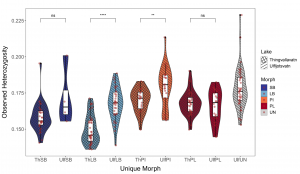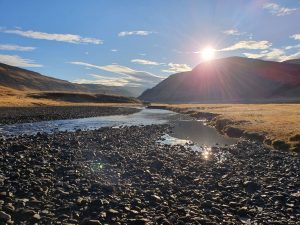The new cohort in MS programme on Aquatic biology and fisheries can choose from a variety of projects.
The coordinator of the programme at the University of Iceland is Dr. Haseeb Randhawa. He maintains a list of projects that students can request to work on.
Here we list three projects that are also offered to students in this programme in the fall of 2025.
Ecological influence on evolution of feeding elements in sympatric morphs
Ecological opportunities can be exploited by organisms and leading to evolutionary divergence and even speciation. Fish show an impressive diversity in feeding specializations, seeming resulting from evolution and ecological opportunities. Data suggest substantial level of phenotypic parallelism in body- and head-shape in Arctic charr, when they radiate into diverse morphs in northern lakes. The research project centers on questions at the intersection of ecological, evolutionary and developmental biology or anatomy. The aim is to study morphological variation in sympatric charr to study the ecological influence on feeding morphology (teeth and bone shape). The over arching questions are: Which feeding traits differ consistently between sympatric morphs across lakes? Does plasticity in feeding traits differ between benthic and pelagic morphs? What is the pattern of evolutionary divergence in upper and lower jaw traits in Arctic charr? The approach will be based on ecological sampling, dissections and morpological and statistical analyses including the use of geometric morphometrics. The student will work with other graduate students in the Arctic charr group at the University of Iceland, and scientsist at the Freshwater division of MFRI and at Universities in Canada. The candidate should have biology or ecology background, numerical skills a strong suit, and have interest in anatomical diversity, ecology, evolution and development.
Supervisors: Arnar Pálsson and Gudbjörg Ósk Jónsdóttir (https://orcid.org/0009-0008-0502-5553) at University of Iceland.
Location: Field work in South-west Iceland and lab work in Reykjavík
Examples of related studies.
Jónsdóttir GÓ, von Elm L-M, Ingimarsson F, Tersigni S, Snorrason SS, Pálsson A, et al. (2024) Diversity in the internal functional feeding elements of sympatric morphs of Arctic charr (Salvelinus alpinus). PLoS ONE 19(5): e0300359. https://doi.org/10.1371/journal.pone.0300359
Genomics of rapid diversification in craniofacial traits related to feeding
The genetic raw material for adaptive evolution can now be studied with whole genome sequencing, and the patterns of positive selection detected in genomes of non-model organisms. Systems with extensive sympatric and allopatric polymorphism can be studied with these methods, to map out patterns of divergence and highlight loci and genomic regions that have been shaped by positive selection in response to ecological diversity. Arctic charr is known for considerable polymorphism and substantial phenotypic parallelism in feeding and body morphology. The aim of this project is to explored the genomics related to craniofacial diversity in sympatric Arctic charr, in reference to anadromous populations (putative ancestors). The research questions are the following: i) which loci and molecular pathways separate ecologically specialized morphs, ii) what is the role of structural variations in maintaining morph separation, and iii) when in development do adaptive traits emerge? The project involves sampling fish in their habitat, processing them and working with students doing phenotypic analyses. The main effort will be DNA isolation and analyses of whole genome sequencing data from the sampled populations, using bioinformatic and population genetic tools and programmes. The ideal candidate should have biology and genetics background, strong bioinformatic and numerical skills are required.
Supervision: Arnar Pálsson, Zophonías O. Jónsson and Gudbjörg Ósk Jónsdóttir at the University of Iceland.
Location: Sampling in South-west Iceland, lab work and analyses in Reykjavík
Examples of related studies.
Han Xiao, Arnar Palsson, Zophonías Oddur Jónsson, et al. Gene flow and habitat heterogeneity shape coexistence dynamics of Arctic charr morphs in connected lakes. Authorea. December 27, 2024.
DOI: 10.22541/au.173531304.47377188/v1
Jónsdóttir GÓ, von Elm L-M, Ingimarsson F, Tersigni S, Snorrason SS, Pálsson A, et al. (2024) Diversity in the internal functional feeding elements of sympatric morphs of Arctic charr (Salvelinus alpinus). PLoS ONE 19(5): e0300359. https://doi.org/10.1371/journal.pone.0300359
Migration patterns and habitat utilization of ecologically diverse fish
Anadromous fihs like salmonids spawn in freshwater, but most return to sea for feeding and growing. While atlantic salmon and brown trout feed in the open seas, arctic charr tends to use coastal habitats and estuaries, at least in Iceland. Arctic charr also migrates into rivers to over winter. The three species, the native salmonids in Iceland, also seem to use different parts of the water ways for spawning and as juvenile habitats. The aim of the project is to explore the habitat utilization and migration patterns of Arctic charr in Icelandic waterways. The main research questions are, i) how widely do the Arctic charr migrate within a major system of waterways in West Iceland? ii) which habitats to the fish choose in different times of the year, and iii) what are the migration patterns (time of year and day) around the spawning grounds in the fall? The questions will be addressed with, new ecological surveys and tagging, fish counter deployment and data gathering, and already collected tracking data on individual fish. The candidate should have background in fish biology or ecology, and ideally have strong numerical skills.
Supervisors: Johannes Guðbrandsson (Marine and Freshwater research institute, https://orcid.org/0000-0002-2231-0910) and Arnar Pálsson at University of Iceland.
Location: West Iceland (Hvanneyri) and Reykjavík.
Examples of related studies.



